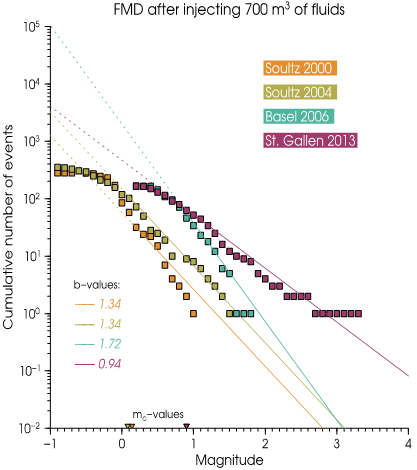In the area surrounding the drilling rig, the SED’s seismic network registered 622 earthquakes with magnitudes ranging from –1.7 to 3.5 up to August 27, 2013. Seismic activity has declined continuously as anticipated since July 14, whereby the number of events registered varies slightly from day to day. The probability of another noticeable earthquake is estimated at between 10 and 20 percent over the next 12 months without further interference with the subsoil. The likelihood of the occurrence of an earthquake with a magnitude of 3.5 or above is between 1 and 3 percent.
Read more...The initial investigation results based on collated data material indicate that the subsoil in St. Gallen reacted intensely to the volumes of water injected and the overall pressure conditions. At the present time, we assume that this can be explained by the critical tectonic tension in the fault zone involved in the drilling. Based on the observed induced seismic activity, the fault zone is considered to be an active fracture zone that is also suspected to be responsible for previous natural earthquakes in the St. Gallen region.
Contrary to an error made commonly even in specialist circles, small earthquakes do not reduce the risk of larger earthquakes occurring within a fault zone. The earthquake that took place on July 20 with a magnitude of 3.5 thus had only a small, inconsequential effect on the overall tectonic tension on the fault plane. In addition, according to our findings it cannot be ruled out that future earthquakes may activate larger subsections of a fault and thereby cause stronger tremors. It is possible that the earthquake that took place in Abtwil in 1835 with a magnitude of 4.7 activated several segments of the St. Gallen fracture zone. Based on today’s circumstances, a comparable earthquake would potentially cause damage costing between CHF 50 million and CHF 200 million.
In terms of the next steps, the SED considers a production test to be less risky than another high-pressure injection. However, an extraction (e.g. in the event of a production test), particularly from a fault zone that has shown itself to be easy to activate, is also not without its seismic risks. It is currently not possible to provide a reliable assessment of the probability of a further noticeable earthquake capable of causing damage and caused by a production test. This probability can, however, be reduced significantly by taking a cautious approach and by terminating the production test prematurely following an unexpected occurrence of microearthquakes. The test should therefore be carried out when the detection capacity of the seismic network is at its best (at night or weekends). Any renewed injection of water or drilling fluid into the fault zone must be avoided.
In order to counter the possible increase in pressure due to the penetration of gas, the use of the otherwise common counterpressure procedure should be avoided if possible. Before larger quantities of water are injected into or extracted from a zone such as this (again), we believe that a broadly based, independent and unbiased risk assessment must have concluded that the associated earthquake risk is acceptable.
The SED is continuing to perform seismic monitoring of the geothermal energy project in collaboration with the St. Gallen public utilities company and the Swiss Federal Office of Energy, and is analyzing the data it receives on an ongoing basis. Details of current seismic activity in the St. Gallen region, as well as further information, can be found on our website at all times.
Presentation by the SED at the media conference in St. Gallen on August 27, 2013
